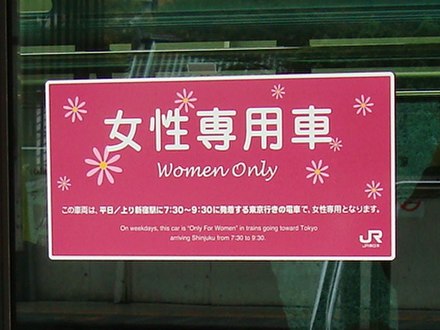Rail travel in Japan
Rail travel in Japan
Rail travel in Japan is perhaps the most efficient way to travel across the country with an extensive network of over 27,000 km of train tracks covering all the four main islands of Japan, served primarily by Japan Railways (JR) in addition to other smaller private and municipal operators. Japan pioneered high-speed trains with the bullet train, known by its Japanese name Shinkansen, which travels along almost the entire length of the country at up to 320 km per hour. As stations are usually placed at the city center and trains are punctual up to the second, traveling by train can be significantly faster than taking an airplane. It's no wonder that more than 24.6 billion passengers traveled by train in 2016, signifying the paramount importance of rail travel to the Japanese.
Understand

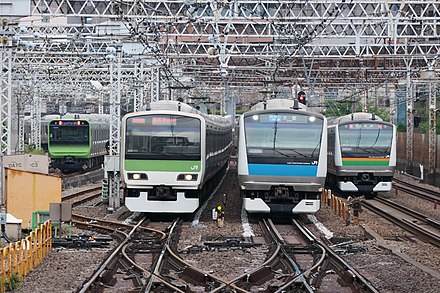 Japan's railways are fast, highly efficient and cover the majority of the country, making this the transport mode of choice for most visitors. The first and most confusing aspect of Japan's railway system (especially within large cities like Tokyo) that you will encounter is the overlap of several private railway networks with the JR network. A given station can host several companies (JR and/or private), or the stations of distinct companies can be located next to the others. Tokyo also has two separate metro systems to add to the confusion. Being aware of this one fact will substantially reduce the confusion you experience trying to understand railway maps and find your way around.
Japan's railways are fast, highly efficient and cover the majority of the country, making this the transport mode of choice for most visitors. The first and most confusing aspect of Japan's railway system (especially within large cities like Tokyo) that you will encounter is the overlap of several private railway networks with the JR network. A given station can host several companies (JR and/or private), or the stations of distinct companies can be located next to the others. Tokyo also has two separate metro systems to add to the confusion. Being aware of this one fact will substantially reduce the confusion you experience trying to understand railway maps and find your way around.
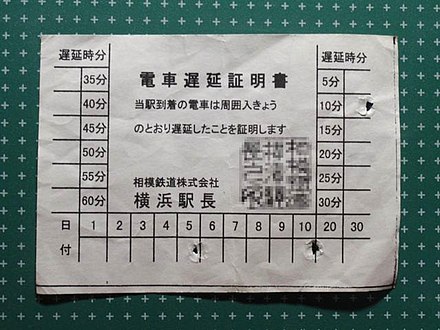
Most trains do not operate 24 hours; for example, in Tokyo they do not run in the early morning 01:00-05:00, and the Shinkansen never runs overnight. If you are planning to be out late and are relying on the train to get home, be sure to find out when the last train is leaving. Many bars and clubs are open until the first train runs again in the morning, so keep this in mind as another option, or tuck in at Internet cafes that are open 24 hours. The lone exception is usually on the evening of December 31, as some companies operate train services throughout the night for New Year's shrine visits.
Finding routes
Route search engines are a fantastic tool, whether you're just starting to plan a trip or are already in the country. For sorting through transport schedules and fares, Navitime computes to-the-minute directions including connecting trains, as well as buses and planes. Jorudan is a similar service, but with fewer options for exploring alternate routes. Google Maps is fine for getting around subways and city trains, but for long distance trips its search options and the routes it presents are much less useful. JR-EAST Train Info (dead link: March 2023) is an app that shows train connection information down to the platform number at the station. The app only shows a map of JR East lines, but it can provide guidance for train lines throughout the country.
The paper version of these is the Daijikokuhyō (大時刻表), a phonebook-sized tome available for browsing in every train station and most hotels, but it's a little challenging to use as the content is entirely in microscopic Japanese. A lighter version that just includes limited express, sleeper and bullet trains (Shinkansen) is available from the Japan National Tourist Organization's overseas offices. English timetables are available on the websites of JR Hokkaido, JR East, JR Central and JR Kyushu. Timetables for the Tokaido, San'yo and Kyushu Shinkansen can also be viewed in English at Tabi-o-ji.
Navitime and Tabi-o-ji offer schedule searches to find routes you can use with the Japan Rail Pass (see below), as does Jorudan with a paid subscription. Navitime is also the only one that can search fares compatible with the Seishun 18 Ticket (see below).
Smart cards
One of the first things any visitor to Japan should do is pick up a public transport smart card (スマートカード sumāto kādo), also called an IC card (ICカード ai shī kādo) or jōsha kādo (乗車カード, "boarding card"). Using a smart card, fares are calculated automatically no matter how complicated your journey or how often you transfer; just tap on and tap off at both ends. In addition to public transport, smart cards are increasingly used for all sorts of electronic payments, so they can be used at vending machines, convenience stores, fast food restaurants, etc.
The ten major ones listed below are fully interchangeable, meaning you can pick up a card in any major city and use it in virtually the entire country, the main exceptions being Shikoku and Okinawa. By region from north to south, they are:
- Kitaca — Hokkaido
- Suica — Tohoku and Kanto
- PASMO — Tokyo
- TOICA — Chubu
- manaca — Nagoya
- ICOCA — Kansai and Chugoku
- PiTaPa — Kansai — A postpaid card linked to your (Japanese) bank account, so this one is not useful for most visitors from abroad
- SUGOCA — Kyushu
- Hayakaken (はやかけん) — Fukuoka
- nimoca — Fukuoka
These cards can be purchased from any station ticket counter and many station vending machines, including those at airports. The base deposit is ¥500 plus the amount you wish to load. The deposit and any remaining value can be refunded when you leave Japan, or you can keep the card for your next visit as they stay valid for 10 years.
You cannot use smart cards themselves to travel between two different regions on regular train services. For example, if you were to start your journey in Tokyo and travel west to Atami using the JR Tokaido Line, you can use a smart card as these stations are within the boundaries of the East Japan Railway (JR East). However, if you continue west of Atami towards Shizuoka you would then enter an area operated by a different company — in this case, Central Japan Railway (JR Central) — and your card would not be accepted when you try to tap out of the system. Traveling between two regions requires a paper ticket, but even smart cards can be accepted at ticket vending machines as payment (your paper ticket would have the letters IC printed on it).
Since September 2017, smart cards have been accepted for travel on the Tokaido and San'yo Shinkansen in lieu of paper tickets. Bullet train tickets can be purchased online with a credit card and tied to a smart card, which can be used to tap in and out of the ticket barriers. The service is available in both English and Japanese via the Smart-EX website.
If you have an Apple iPhone or Watch, it's possible to add Suica/PASMO to your Apple Wallet and pay with your device. Android users are mostly out of luck. While Google Pay does support the cards, most non-Japanese Android devices do not have the necessary "Osaifu-Keitai" (FeliCa) chip installed.
Buying a short-distance ticket
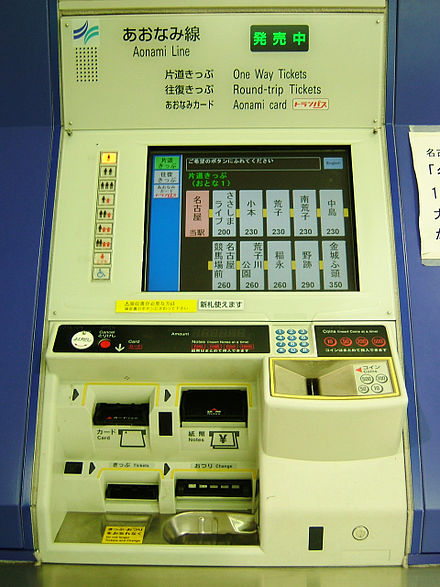 In some cases, you may still need to buy paper train tickets, such as when crossing from one region to another, or in remote areas that don't accept smart cards yet.
In some cases, you may still need to buy paper train tickets, such as when crossing from one region to another, or in remote areas that don't accept smart cards yet.
Most train tickets in Japan are priced by distance, so there will be a map above the ticket machines. Near the center, the current station is usually marked in red with <span style="color:red">当駅</span> (tōeki). Around it will be all other stations you can get to with a price below them. The nearer stations have the smaller numbers (e.g. the closest stations will probably be about ¥140, more distant ones rising to perhaps ¥2,000). As long as you stay on the same rail system, you can take any route and transfer between trains for free.
To buy a ticket, insert coins or cash into the ticket machine. As you do, options will light up for the tickets you can buy with that amount of money. Usually you just need a regular ticket for the correct amount, but for some journeys you may need to purchase a transfer fare or some other special option.
The coin slot is large so that you can insert multiple coins at once. One trick is to dump your whole change purse in; whatever change you get back will be in the largest coins possible, reducing the amount of small change you're carrying (except for pesky ¥1 or ¥5 coins, which machines pass through and don't accept as payment).
Insert the ticket at the fare gate and don't forget to pick it up once you are through. Don't throw away the ticket yet; you have to insert it again when exiting the fare gates at the end of your journey.
If you cannot figure out the price, buy a minimum fare ticket and pay when you arrive at your destination. You can either present your ticket to the staff at the gate, or pay the balance at the "Fare Adjustment" machine. Look for a small ticket vending kiosk before the exit fare gate. Insert your minimum fare ticket and pay the balance indicated on the screen.
At unmanned stations
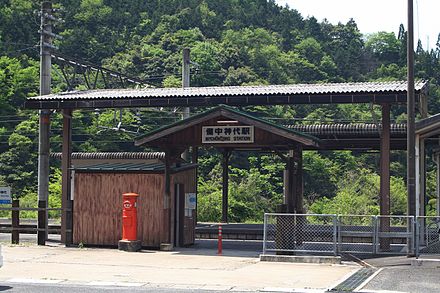 Unlike in major cities and suburbs, in rural areas there are a good number of unmanned stations where there are no ticket gates or ticket vending machines. In these cases, you'll likely have to take a seiriken (整理券) or numbered ticket when you get on the train, and settle the fare with the driver or conductor before you get off. At the front of the train will be a display board with numbers and fares that increase as the journey goes on. When you disembark, surrender your seiriken and pay the amount indicated next to your number. On most of these services you'll board at the rear of the train (denoted by 入口 or "entrance") and exit at the front of the train (denoted by 出口 or "exit"). Also note that most trains, like buses, have fare collection machines that only accept coins.
Unlike in major cities and suburbs, in rural areas there are a good number of unmanned stations where there are no ticket gates or ticket vending machines. In these cases, you'll likely have to take a seiriken (整理券) or numbered ticket when you get on the train, and settle the fare with the driver or conductor before you get off. At the front of the train will be a display board with numbers and fares that increase as the journey goes on. When you disembark, surrender your seiriken and pay the amount indicated next to your number. On most of these services you'll board at the rear of the train (denoted by 入口 or "entrance") and exit at the front of the train (denoted by 出口 or "exit"). Also note that most trains, like buses, have fare collection machines that only accept coins.
You can use a smart card on the train if it is supported. Tap your smart card when boarding, and again when you exit, and the fare is automatically deducted. In some stations, entrance and exit readers are located on the station platform. If you are using a JR train and have a Japan Rail Pass, simply show your Rail Pass to the driver as you exit. You will be informed of any fare difference that is owed.
If you disembark at a manned station, hand your seiriken and your fare to a manned station agent at the ticket gates. Conversely, if you get on at a manned station and exit at an unmanned station, hand your ticket to the driver before you get off.
Trains where the role of the driver and conductor are combined are called "one man" trains, and will have a sign in romaji characters (ワンマン) at the front of the train.
JR network
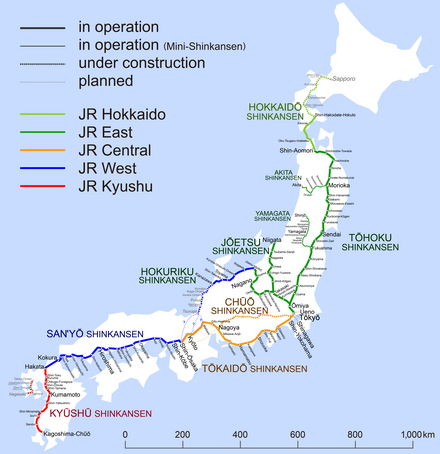
The JR network is extensive as one would expect from what used to be the national rail system. The JR Group operates the Shinkansen lines, as well as a multitude of regional and urban mass transit lines. In the countryside the group companies also run bus services to connect places that don't have a rail service. However, the JR network is not a monopoly and particularly within major conurbations there are other private rail networks.
Interestingly, people refer to JR in Japanese by its English initials, jē āru. Hopefully even non-English speakers can help you find a station if you ask.
Japan Rail Pass
Shalt thou Pass?
Quick rule of thumb: an advance-purchase 7-day Rail Pass costs about the same as a single Tokyo-Osaka full-fare round trip by Shinkansen (as of 2022, just under ¥30,000). Throw in a few airport express trains, or perhaps a visit to Himeji or Hiroshima, and the Rail Pass starts to pay off.
By far the best option for visitors who plan to do a lot of travelling is the Japan Rail Pass, which allows unlimited travel on almost all JR trains, including the Shinkansen, and travel on certain segments on private railways (see exceptions below) for a fixed period of 7, 14 or 21 days. In general, it is good value for money if you plan to do a lot of long distance travelling, but not worth it if you intend to stay primarily in a single city and its vicinity.
In order to be eligible for the Japan Rail Pass, you must be a foreign national visiting Japan as a tourist (with the temporary visitor stamp in your passport), or a Japanese national who has lived outside of Japan for at least ten years. If you're using the Japan Rail Pass as a Japanese national, you'll need to show specified proof such as documentation obtained from the consulate or embassy of Japan where you live in addition to your Japanese passport. Some regional passes, such as the JR EAST PASS for the Tohoku area or the Nagano-Niigata area, are available for anyone who possesses a non-Japanese passport.
You can purchase a Japan Rail Pass before your departure to Japan or after your arrival. Advanced purchases can be made online directly from Japan Railways (through the Japan Rail Pass Reservation website) or through the means of a voucher sold by a travel agency that is exchanged in Japan for the pass. Japanese nationals living abroad must obtain rail passes through the voucher system. Japanese nationals living abroad will be able to purchase Exchange Orders until at least December 31, 2023.
Prices if purchased through JR/purchased after arrival
| | | | Class | | ! 7 Days | ! 14 Days | ! 21 Days | | Green Car | ! Adult | ¥44,810 | ¥72,310 | ¥91,670 | | Green Car | ! Child | ¥22,400 | ¥36,150 | ¥45,830 | | Standard Car | ! Adult | ¥33,610 | ¥52,960 | ¥66,200 | | Standard Car | ! Child | ¥16,800 | ¥26,480 | ¥33,100 |
Prices if purchased before departure through a travel agent (exchange voucher)
| | | | Class | | ! 7 Days | ! 14 Days | ! 21 Days | | Green Car | ! Adult | ¥39,600 | ¥64,120 | ¥83,390 | | Green Car | ! Child | ¥19,800 | ¥32,060 | ¥41,690 | | Standard Car | ! Adult | ¥29,650 | ¥47,250 | ¥60,450 | | Standard Car | ! Child | ¥14,820 | ¥23,620 | ¥30,220 |
You must go to a manned ticket agent at a major JR station and present your passport to pick up the Japan Rail Pass. If it was purchased in advance, you will need to show either proof of purchase (if the pass was purchased through JR) or your exchange voucher (if purchased through a travel agency). If exchanging a voucher, you must inform the ticket agent of the date that you want the rail pass to start. Dedicated counters with English-speaking staff are available at major airports such as Haneda, Narita and Kansai. There are also counters specifically for rail pass pickups at major JR stations such as Tokyo, Shinjuku, Ueno, Nagoya, and Sapporo.
Unlike the previous paper versions, the Japan Rail Pass comes in the form of an actual magnetic train ticket with a printed QR code unique to the user. You can use the ticket to pass through the automatic ticket barriers as you enter and exit the train station.
The rail pass includes free seat reservations on eligible JR trains, including most shinkansen and limited express services. If you purchased the pass in advance through JR, you can make online seat reservations as soon as you have purchased your pass. Once the rail pass has been obtained, reserved seat reservations can be made or collected at a JR station using the reserved ticket machine. You will be able to access the machines by scanning the QR code printed on your rail pass (or entering the identification number printed on the pass) and then entering your passport number. Even if seat reservations were made online, the actual seat reservation tickets must be printed out at the ticket machine and in your possession before boarding the train. Note that with the automated system, seat reservations are linked to each individual Rail Pass and you will not be permitted to reserve services that overlap with each other. This isn’t usually a problem, but if you miss your reserved train you may not be able to make a reservation for the next departure right away. For unreserved seating, no ticket is needed; just show your rail pass when the conductor comes through checking tickets.
As the exchange voucher system will continue to be in place until at least the end of 2023, it may still be worth buying the voucher instead of ordering straight from JR since the prices will be lower. On the other hand, if you need to book a specific train service before your arrival in Japan, it may be worth purchasing the pass ahead of time. Passes purchased through JR must commence within one month of purchase, while vouchers can be exchanged within three months of purchase.
The rail pass does have a few exceptions:
- If you travel on the Tokaido, San'yo, or Kyushu Shinkansen, the Japan Rail Pass does not allow travel on the faster Nozomi or Mizuho services — you'd have to pay the full fare and seat fee. Search engines like Navitime and Tabi-o-ji have options to exclude these trains, but Google Maps and others don't.
- Many of the newer trains on the shinkansen networks of JR East have a premium first class cabin known as "GranClass". You cannot use the GranClass cabin with any Japan Rail Pass unless you pay the limited express and GranClass surcharges (i.e. ¥27,220 on the Hayabusa if going from Tokyo all the way to Hakodate).
- You must pay extra surcharges for JR trains that travel on tracks not owned by JR. Some examples include:
- The Tokyo Waterfront Railway (TWR) Rinkai Line between Osaki and Shin-Kiba, used to access Odaiba
- The Izukyu Railway from Ito to Shimoda on the Izu Peninsula
- The Kyoto Tango Railway from Fukuchiyama to Toyooka, which is used by JR trains running from Kyoto to Amanohashidate
- If you stay in a private compartment — available on overnight trains and a small number of Shinkansen trains between Osaka and Fukuoka — you must pay the limited express and accommodation charges.
A few extras are included:
- The JR Pass covers travel to and from isolated JR rail lines on private railways provided that no stopovers occur on the following segments:
- Between Hachinohe and Noheji, between Aomori and Noheji, and between Hachinohe and Aomori on the Aoimori Railway for access to the JR Ominato Line.
- Between Kanazawa and Tsubata on the IR Ishikawa Railway for access to the JR Nanao Line.
- Between Toyama and Takaoka on the Ainokaze Toyama Railway for access to the JR Johana and Himi Line.
- The JR Pass covers travel, including stopovers, on the Tokyo Monorail from Haneda Airport to Hamamatsucho in Tokyo.
- The JR Pass covers travel on the JR Ferry to Miyajima.
Regional rail passes
Regional JR companies also sell their own passes that cover only parts of the country. If you plan on visiting only one or two regions then they may be a better deal than the standard JR pass however if you plan on visiting multiple regions in a short amount of time the JR pass is probably better. From north to south:
- Hokkaido: JR Hokkaido Rail Pass
- Tohoku:
- Kantō: JR East Tokyo Wide Pass (also covers some private rail lines)
- Chūbu:
- JR East/JR West Hokuriku Arch Pass – Covers travel between Tokyo and Kansai via the Hokuriku region, and also covers some private rail lines
- JR East Rail Pass – Nagano/Niigata Area (also covers Kanto and some private rail lines)
- Aozora Free Pass - Weekend and holiday pass for local JR trains in Aichi, Mie, Gifu prefecture up to Gero, and southern Nagano
- Chugoku: JR West sells several, including:
- Kansai-Hiroshima Area Pass
- San'yo-San'in Area Pass
- Kansai Wide Area Pass
- Shikoku: All Shikoku Rail Pass (also covers private rail lines and trams), Shikoku Saihakken Kippu
- Shikoku Birthday Kippu - A 3 day ticket covering all JR trains, as well as the private Kuroshio Railway in Kochi Prefecture in the month of the purchaser's birthday. Purchaser may buy a set number of additional tickets for travel companions regardless of their birthdays, Green Car option available
- Shikoku Free Pass - 3 Day pass providing access to all JR trains in Shikoku, more costly but more flexible than the Birthday Kippu
- Kyushu: All Kyushu Area Pass, Northern Kyushu Area Pass (covers areas north of Kumamoto and Oita)
Many JR East and JR West rail passes can be purchased online in advance at a discount of between ¥500-1,000, while other passes must be purchased when inside the country.
Seishun 18 Ticket
Main article: Seishun 18 Ticket
The Seishun 18 Ticket (青春18きっぷ Seishun jūhachi kippu) is the most economic deal for travel in Japan, offering five days of unlimited train travel for just ¥12,050. Better yet, unlike the Rail Pass, the days do not have to be consecutive. You can even split a ticket so that (for example) one person uses it for two days and another for three days. The main catches are that tickets are only valid on local trains and that tickets are valid only during school holidays (March–April, July–September, December–January), so you need good timing and plenty of time on your hands to use it.
Buying a long-distance ticket
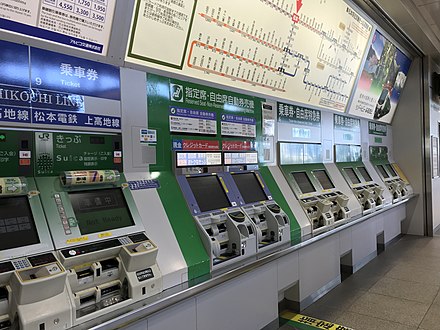
 Standard JR tickets are usually split into two categories:
Standard JR tickets are usually split into two categories:
- Basic Ticket or jōshaken (乗車券): These tickets cover the basic fare for trains operating between two stations/areas. Stopovers are permitted on long trips, though you must stay on the ticketed route and cannot backtrack. Tickets are valid for 2 days for journeys over 100km, 3 days for journeys over 200km, and then one day for each additional 200km.
- Limited Express Ticket or tokkyūken (特急券): With a few variants on the name, limited express tickets are purchased for premium long-distance trains, including the Shinkansen. Generally, unreserved (自由席 jiyūseki) tickets are valid for unreserved seats on any service, while reserved (指定席 shiteiseki) tickets are valid for a specific train.
At major stations there will be an obvious travel section where you can buy your ticket from a human being; look for the little green sign of a figure relaxing in a chair or ask for the midori no madoguchi (みどりの窓口, lit. "green window"). Since you probably need to know the train times and may want to reserve a seat as well this is a good thing. Generally speaking you can make your desires known by means of hand waving and pointing at destinations if the staff are unable to speak English. Writing down information helps as most Japanese have a much easier time reading English than hearing it.
For express trains that require a surcharge and seating reservation, you will usually be able to find a staffed window. However, some trains have their own specific machines to do this. First, buy a regular train ticket to your destination. On the touchscreen machines, there will usually be a button for express services. Choose the name of the service you wish to travel on, your destination, preferred departure time and seating preferences, and then insert the surcharge amount. You will be issued a reservation card showing the departure time and your seat number. You must also have either a travel ticket, pass, or smartcard to get through the ticket gates: a surcharge on its own is not valid for travel.
General purpose automatic ticketing machines are becoming more prevalent. These machines can be made to display English and are able to issue long-distance fare tickets and limited express tickets for both reserved and unreserved seats. They are usually located around ticketing windows. When buying fare tickets, take note of the route displayed, as you are required to travel on the ticketed route (stopovers are not allowed outside of that route).
For unreserved local trains, just use your smart card. If the fare happens to cost more than you had left on the card, you can pay the difference at a ticket counter or fare adjustment machine at the destination station. However, if your journey crosses the boundaries of different operators then there is the possibility that your smart card will not be accepted. Further, some stations do not have smart card readers. Details of such limitations can usually be found near the boundaries of different rail companies or on the websites of card issuers. It is recommended to always buy a fare ticket at a ticket machine or a ticket counter when traveling long-distance. Additionally, doing so may enable you to buy a fare ticket all the way to your final destination, making stopovers in between, which may save you plenty of money due to the fare per kilometer being cheaper the longer the ticketed distance.
If you happen to use a smart card mistakenly, you will settle the fare at the destination and the station staff or conductor will write you some kind of proof that you will take either to a nearby station or the origin station for them to unlock your card.
Examples of smart card boundaries can be found on the Tōkaidō Main Line between Tokyo and Kansai (not the shinkansen): Between Atami (JR East) and Kannami (JR Central), and between Samegai (JR Central) and Maibara (JR West).
Train types


JR pioneered the famous bullet train, referred to by its Japanese name Shinkansen (新幹線). With speeds of up to 320 km/h (360 km/h in the near future), these services are classified as "superexpress" (超特急 chō-tokkyū) and remain the fastest way to travel around the country. Note that the Shinkansen does not run overnight. The Shinkansen is also known for its enviable safety record, with not a single accident resulting in a passenger fatality since it began operation in 1964.
Tokaido/San'yo/Kyushu Shinkansen
Poetry in motion
JR refer to the various services of the Shinkansen by their Japanese names even in English, but if you look at what the words mean, some of them are quite evocative.
- Shinkansen means "new trunkline/mainline". It refers to both the tracks (Shinkansen run on dedicated tracks, completely separated from all other trains) and the services that run on them, forming the new core of the Japanese train network.
- Unbeknownst to most Japanese today, bullet train is actually a translation of dangan ressha, the earliest name used when the Shinkansen project was in the planning stages, which stuck in English because it matched the distinctive nose (and of course the high speed) of the original 0 Series Shinkansen.
- The first Shinkansen offered two services. One was Kodama, or "Echo", named because you could get from Tokyo to Osaka and back in one day. Sound travels very fast, but Hikari, or "Light", travels even faster.
- In 1992 they added a faster service, but what could be faster than light? The answer, apparently, is something more human: Nozomi, or "Hope".
- A train to Akita has a name derived from Ono no Komachi, a famously beautiful 10th century poet from that area. Because of her, in modern Japanese Komachi figuratively means "Belle" or "Beauty".
- The public chose Kagayaki, or "Glitter", to represent "glittering light that conjures a sense of speed and a brightening future".
- The name Hayate, or "Strong Wind", carries positive connotations of speed and power.
- Some services are named for symbols of Japan. Sakura, or "Cherry Blossoms", have been appreciated in Japan for several centuries, and abroad are commonly associated with Japan. Mizuho is more figurative: meaning approximately "Abundant Rice", it can loosely mean "Harvest", and Mizuho-no-kuni ("Land of Abundant Rice") is an ancient name for Japan.
- Yamabiko is an unusual one: it's the name of a type of "Mountain Spirit" from Japanese folklore. Yamabiko also means "Echo" (the same as Kodama), because that's what this spirit does: it's the spirit that creates echoes in mountains or canyons.
- Many trains are given names relating to birds, such as the obvious Tsubasa, or "Wings". The endangered Toki, or "Crested Ibis", is found only in East Asia. Hakutaka, or "White Hawk", is the name of a legendary bird from folklore that appears once in a thousand years, which in some stories is associated with the area served by that train. The Tsubame, or "Swallow", is a common icon of summer, the period when they nest in Japan. And Hayabusa, or "Peregrine Falcon", is extremely appropriate: these birds of prey can reach speeds of 320 km/h in a dive, which is as fast as the fastest Shinkansen! Kamome ("Seagull") is used on the Nishi-Kyushu bullet train services to and from Nagasaki.
- Rounding out the set, the remaining names are generally named for geographical features in the area served by the trains: the Nasu highlands (served by the Nasuno), Mount Tanigawa, Mount Asama, and Mount Tsurugi.
The most important, most-travelled Shinkansen route in the country is the Tokaido Shinkansen, which links Tokyo with Nagoya, Kyoto and Osaka. This line continues from Osaka to Okayama, Hiroshima and Fukuoka (Hakata station) as the San'yo Shinkansen, then to Kumamoto and Kagoshima as the Kyushu Shinkansen.
There are a total of six different types of services operating on the Tokaido, San'yo and Kyushu Shinkansen lines. These can all be grouped into three types, reflecting the number of stops made:
- Nozomi (のぞみ), Mizuho (みずほ)
These two services are the fastest, making stops only at major cities. A small surcharge on top of the Shinkansen fare is required, and seat reservations are mandatory for all but three cars on the train. Most importantly for tourists, the Japan Rail Pass is not valid on Nozomi or Mizuho trains.
The Nozomi is the primary service that runs through both the Tokaido and San'yo Shinkansen lines, though some other Nozomi trains run only between Tokyo and Osaka. This train type has a frequent service of up to every 10 minutes on weekdays and runs with 16 cars. A one-seat journey on the Nozomi from Tokyo to Osaka takes 2 hours 30 minutes, while trips from Tokyo to Fukuoka take 5 hours. Seamless transfers can be made at Fukuoka between the Nozomi and Kyushu Shinkansen trains: Tokyo to Kumamoto is 6 hours, and the full run from Tokyo to Kagoshima is about 7 hours.
The Mizuho, on the other hand, is limited to services on the San'yo and Kyushu Shinkansen between Osaka and Kagoshima, with trips operating in the morning and evening "peak" hours. Mizuho trains run from Osaka to Kumamoto in 3 hours, and to Kagoshima in 3 hours, 45 minutes. Mizuho trains only runs with 8 cars and has a shared reserved and green seats on car 6.
- Hikari (ひかり), Sakura (さくら)
These are the fastest services valid with the Japan Rail Pass, making a few more stops than the Nozomi or Mizuho. On the Tokaido Shinkansen, there are usually two Hikari trains per hour that depart from Tokyo: One train terminates in Osaka, and the other continues on the San'yo Shinkansen, terminating in Okayama. West of Osaka there is generally one Sakura train per hour (two during commuting hours) that runs from Osaka to Fukuoka and on to Kagoshima. Other Sakura services run only between Fukuoka, Kumamoto and Kagoshima on the Kyushu Shinkansen.
If you use the Hikari or Sakura with a Japan Rail Pass you will typically need to transfer at least once for long journeys. For trips on the Tokaido and San'yo Shinkansen, the best place to transfer is at the terminal at Shin-Osaka. You could also consider a transfer at Shin-Kobe, where trains arrive and depart on the same track. Depending on the timetables, it might also be best to change at Himeji or Okayama, which offer same-platform changes.
Departing Tokyo with these services you can reach Osaka in 3 hours, Fukuoka in 6 hours, Kumamoto in 7 hours and Kagoshima in 8 hours. From Osaka you can get to Fukuoka in less than 3 hours, Kumamoto in 3 hours 30 minutes and Kagoshima in 4 hours 15 minutes.
- Kodama (こだま), Tsubame (つばめ)
Also valid with the Japan Rail Pass, these are the all-stations services stopping at every shinkansen station on the route. Tokaido Shinkansen Kodama services generally run from Tokyo to Osaka and Tokyo to Nagoya. Separate all-station Kodama services run on the San'yo Shinkansen, and Tsubame trains run only on the Kyushu Shinkansen between Fukuoka, Kumamoto and Kagoshima. While Tokaido Kodama trains operates 16 cars, San'yo Kodama and Kyushu Tsubame services may operate with fewer cars, so be sure to check the signs on the platform for your proper boarding location.
Other Shinkansen routes
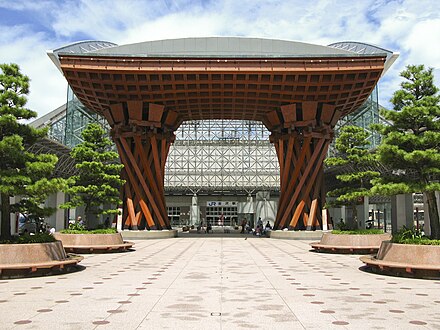
Japan's other bullet train routes are operated primarily by JR East and radiate north of Tokyo station. These include:
- Tohoku Shinkansen to Sendai, Morioka and Aomori, continuing to Hakodate as the Hokkaido Shinkansen
- Akita Shinkansen to Akita, coupled with Tohoku Shinkansen trains as far as Morioka
- Yamagata Shinkansen to Yamagata and Shinjo, coupled with Tohoku Shinkansen trains as far as Fukushima
- Joetsu Shinkansen to Yuzawa and Niigata
- Hokuriku Shinkansen to Nagano, Toyama and Kanazawa
- Nishi-Kyushu Shinkansen to Nagasaki. Operated by JR Kyushu, but only up to Takeo-Onsen where you'll need to take a regular train to rejoin the main Kyushu Shinkansen at Tosu or Fukuoka.
The Japan Rail Pass is valid for all of these services, except for the GranClass cabin operating on certain routes (additional fare is required).
Other JR train types
Other JR services, particularly suburban ones, use the following generic labels:
- Regular/Local (普通 futsū, 各停 kakutei, or 各駅 kakueki) – stops at every station
- Rapid (快速 kaisoku) – skips approximately 2 out of 3 stops, no surcharge
- Special Rapid/New Rapid (新快速 shinkaisoku) — faster service unique to JR West and Central, only stops at designated stations, no surcharge
- Express (急行 kyūkō) – skips approximately 2 out of 3 stops, requires a surcharge (less common on JR these days compared to locals and rapids)
- Liner (ライナー rainā) – skips approximately 2 out of 3 kyūkō stops, requires a surcharge
- Limited Express (特急 tokkyū) – skips approximately 2 out of 3 kyūkō stops, requires a surcharge and usually a reserved seat as well
Green Cars
 Express services may offer first-class Green Car (グリーン車 guriin-sha) seats. Given that the surcharge of almost 50% gets you little more than a bit of extra leg room, most passengers opt for regular seats. However, if you really need to ride a particular train for which the regular seats are full, the Green Car is an alternative. The JR pass is available in two types: "Ordinary", which requires paying the surcharge to use the Green Car, and "Green", which includes Green Car seats at no additional charge.
Express services may offer first-class Green Car (グリーン車 guriin-sha) seats. Given that the surcharge of almost 50% gets you little more than a bit of extra leg room, most passengers opt for regular seats. However, if you really need to ride a particular train for which the regular seats are full, the Green Car is an alternative. The JR pass is available in two types: "Ordinary", which requires paying the surcharge to use the Green Car, and "Green", which includes Green Car seats at no additional charge.
Depending on where you travel in Japan, Green Cars do have some little perks. On the premium Nozomi and Mizuho (not valid with the rail pass) you are greeted by a female attendant who will bow to you as you enter the train and check your tickets in place of the train conductor. Depending on the day and time that you travel, Green Cars can be less crowded and quieter than the regular cars, but, of course, during Golden Week and other high-peak travel periods, all bets are off.
GranClass

GranClass on the fastest services offers a personal in-cabin attendant, an increased selection of soft drinks and alcoholic beverages, and premium quality food items made with local ingredients. GranClass may also be offered on slower, stopping services during the morning and evening peak periods, but food and attendant services will not be available.
A special GranClass fare structure is in place for these services. Holders of the Japan Rail Pass and JR East Rail Pass will need to pay the limited express fare and the GranClass fare to travel in GranClass. Even if you have a Green Car pass, it will still cover just the basic fare — however, trains with GranClass also offer regular Green Car seating which can be used for no extra charge with the Green Car pass.
Smoking
Many of Japan's rail companies have restricted or banned smoking on platforms and on trains.
Only a very few long-distance services and bullet trains have segregated carriages for smokers, including on some of the older bullet trains that are in service. Most others - including the new and refurbished bullet trains - restrict smokers to small ventilated rooms, known as "smoking corners", in between certain cars. All suburban and commuter services, and many long-distance trains, do not permit smoking at all.
Usually non-smoking trains are marked in timetables with the universal no-smoking sign, or with the Japanese kanji for no smoking (禁煙; kin'en).
Food and beverage
.jpg/440px-Ekiben_(44548722260).jpg) When taking a shinkansen or long-distance limited express service, it's best to buy any food or beverages for consumption before boarding your train.
When taking a shinkansen or long-distance limited express service, it's best to buy any food or beverages for consumption before boarding your train.
Consider purchasing an ekiben (駅弁), which are packaged meals sold at train stations intended to be eaten on trains. Every large station has several stalls selling ekiben, and even medium-sized stations will typically have some available. Every ekiben is different and represents the taste of the region from where it was packaged. Some major Shinkansen stations such as Tokyo and Shin-Osaka will have stores selling ekiben from all over the country. It's not uncommon for Japanese to pick up an ekiben along with a beer or can of sake and have a mini-party on the train, a custom you could happily adopt.
Some major stations will have restaurants or quick-service eateries in their station concourses or even on the platforms themselves where you can have a bite to eat before taking your train. The Shinkansen platforms at Nagoya, for example, have a few noodle shops just steps away from where the bullet trains pull in.
On-board food and beverage sales are still available on some services, although this has been declining, particularly on JR services. If a train does have at-seat catering, there will often be a selection of ekiben available, but it's usually more expensive and more limited than what's available at stations.
Food and beverage consumption is not permitted on regular commuter trains. Generally speaking, if you have your own seat with a tray table, it's okay to eat and drink on the train.
Making a reservation

On Shinkansen and tokkyū trains, some of the carriages require passengers to have reserved their seats in advance (指定席 shiteiseki). For example, on the 16-carriage Hikari service on the Tokaido Shinkansen, only five of the carriages permit non-reserved seating, all of which are non-smoking (禁煙車 kin'ensha). On a busy train, making a reservation in advance can ensure a comfortable journey. Especially consider it if you're travelling in a group, as you're unlikely to find 2 seats together, let alone more, on a busy train.
Making a reservation is surprisingly easy, and is strongly advised for popular journeys (such as travelling from Tokyo to Kyoto on a Friday evening, or taking a train from Nagoya to Takayama). Many JR stations have ticket machines where seat reservation tickets can be purchased; the newer machines have multi-language options in English, Chinese and Korean. Alternatively, look out for the JR Office at the train station, which bears a little green logo of a figure relaxing in a chair - and ask to make a reservation when you buy your ticket. The reservation can be made anywhere from a month in advance to literally minutes before the train leaves. Note that the opening hours of the manned ticket offices (dedicated to long distance travels) are more limited than the ones for local trains: they may be closed early in the morning or late in the evening.
If you are a Japan Rail Pass holder, reservations are free: Go to a ticket machine for reserved seating and push the "JAPAN RAIL PASS" button at the bottom of the screen to get started, or go to a manned agent at the JR Office and present your Rail Pass when requesting a reservation.
Without a pass a small fee will be charged, so a non-reserved ticket may be preferable to a reserved ticket, particularly if you are boarding at Tokyo or another originating station where all the seats will be open anyway.
Online reservations
There are several online services that foreigners can use to make advanced reservations for many JR trains in English and several other languages. There are more of these reservation services available than in previous years, but each of them has their advantages and drawbacks.
SmartEX
The SmartEX App allows online reservations to be made for Tokaido, San'yo and Kyushu Shinkansen bullet trains (i.e. services between Tokyo, Nagoya, Kyoto, Osaka, Hiroshima, Fukuoka and Kagoshima) from mobile devices. After registering and providing a valid credit card, bullet train tickets for these lines can be purchased. Travelers can pick up their reserved tickets at a vending machine prior to boarding, or use a valid IC card or QR code to tap in and out of the Shinkansen system. The SmartEx App entitles users to a discount of ¥200 off of regular tickets, with additional discounted "Hayatoku" fares subject to availability.
Reservations can be made from one month until four minutes prior to a train's scheduled departure time, and tickets can be picked up from any JR ticket machine with the EX logo (JR Central, JR West and JR Kyushu stations, plus JR East stations in Tokyo and along the Tokaido Shinkansen route). However, there is no provision to make reservations if you have a Japan Rail Pass.
JR East Train Reservation service
The JR East Train Reservation website sells JR East and JR Hokkaido Rail Passes, and allows regular travelers and Rail Pass holders alike to reserve seats on the following services:
- All Shinkansen trains except Tokaido, San'yo and Kyushu Shinkansen services
- Key JR East Limited Express trains to and from Tokyo, including the Narita Express
- All JR Hokkaido Limited Express trains
- Airport Rapid trains to and from New Chitose Airport in Sapporo
Seat reservations through JR East's site may be made anywhere from one month up to three days before the date of travel, and your ticket must be picked up at a JR East ticket counter any time up to 21:00 on the day prior to departure. Also, the basic fare is not included in the seat reservation cost, unless you have a valid rail pass.
If you are in Tokyo, you can also take advantage of the JR East Travel Service Center for foreigners at Haneda Airport, Narita Airport, and major train stations in Tokyo and the Tohoku regions. You can easily exchange rail pass vouchers, purchase tickets or make seat reservations with staff that speak multiple languages.
JR West Train Reservation service
The JR West Train Reservation website allows users to reserve seats on the following services:
- All Tokaido, San'yo, Kyushu, Nishi-Kyushu, Joetsu and Hokuriku Shinkansen services
- Tohoku Shinkansen services between Tokyo and Nasu-Shiobara (does not include services further north to Fukushima, Sendai, Akita, Hokkaido, etc.)
- All limited express services in central and western Japan, including the islands of Shikoku and Kyushu (in areas operated by JR Central, JR West, JR Shikoku and JR Kyushu)
- Limited express services around Tokyo and portions of the Kantō, Chubu and Tohoku regions (in areas operated by JR East)
Regional JR West rail passes and travel products can also be purchased through the JR West service.
Reservations can be made up until minutes before departure. Payment can be made in advance by credit card, or in yen (cash) when picking up the tickets in person. Tickets can be picked up at these locations:
- Any ticket office or ticket reservation machine in central or western Japan showing the e5489 (ii go-yoyaku, a pun on "e-reservations") reservation system symbol
- JR East Travel Service Centers, except for trains that pass through JR Central territory, such as the Tokaido Shinkansen.
If you are picking up a regional rail pass or tickets that are restricted to foreign tourists, these must be picked up at a JR West station in western Japan. You can go to an e5489 ticket office, or if you have a passport with an IC chip, you can go to an e5489 ticket reservation machine that is equipped with a passport reader.
If you reserve tickets on the Tokaido Shinkansen from Tokyo using the JR West Reservation Service, you will need to travel to a Tokaido Shinkansen train station (i.e. Tokyo Station, Shinagawa, Shin-Yokohama) and go to a JR Central ticket office or e5489 reservation machine to receive your tickets.
Kyushu Rail Pass Reservation service
The Kyushu Rail Pass Reservation website permits foreign travelers to purchase a Kyushu Rail Pass, and allows Kyushu Rail Pass holders to make seat reservations on trains in Kyushu.
Luggage
On all bullet trains and limited express services, there is an overhead rack where personal items and small luggage can be stored. There is also a limited amount of space at the rear of each car for a few large suitcases (some of these spaces need special reservations, see below). Bringing large luggage is generally discouraged for personal space and comfort considerations, both for yourself and other passengers. As an alternative to bringing large luggage on the train, you may wish to look into a luggage delivery service, which in Japan is a highly efficient and economical way to transport your luggage. For example, a suitcase measuring not more than total in length, width and height costs just under ¥2000 to transport between Tokyo and Kyoto on Yamato's Ta-Q-Bin (宅急便 takkyūbin) service with next day delivery. Long distance deliveries (i.e. Tokyo-Fukuoka) can take two days, and one extra day must be added for deliveries to an airport. Most hotels and convenience stores will be able to make the necessary arrangements for you and accept payment.
A growing number of trains are installing large storage spaces for luggage. Many of the newer express services on JR and private railways have luggage compartments at the end of some cars, while a few trains such as the Hinotori between Nagoya and Osaka have free luggage lockers.
Luggage reservations
The Tokaido, San'yo and Kyushu Shinkansen requires all passengers with large luggage between 161-250 cm (length plus width plus height) to make a special seat reservation (特大荷物スペースつき座 tokudai nimotsu space tsuki seki). This reservation, at no additional cost when purchasing a ticket, allows passengers with large luggage to reserve seats in the back row of a reserved car and store the luggage behind their seats.
Those who do not make this special reservation are supposed to store their luggage in a designated space between cars at a cost of ¥1000 for each piece, although in practice, enforcement of this is lax as long as the in-car luggage slots are not full.
You do not need to make reservations for carry-on size luggage, which fits into the racks above the seats.
Private railways
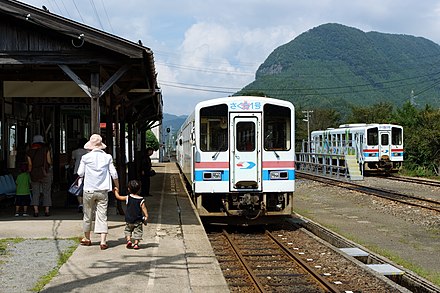
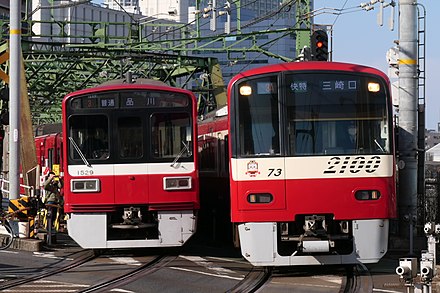 If the option is there, the private railways are often cheaper than JR for an equivalent journey. However this is not always the case as changing from one network to another generally increases the price. Most private railways are part of large conglomerates with many holdings in other business areas like real estate and shopping, and focus on commuter service into the major cities - the only private railway that could be considered intercity is the Kintetsu Railway linking Nagoya and Osaka. Private railways may interpret the service classes above differently, with some providing express services at no additional charge.
If the option is there, the private railways are often cheaper than JR for an equivalent journey. However this is not always the case as changing from one network to another generally increases the price. Most private railways are part of large conglomerates with many holdings in other business areas like real estate and shopping, and focus on commuter service into the major cities - the only private railway that could be considered intercity is the Kintetsu Railway linking Nagoya and Osaka. Private railways may interpret the service classes above differently, with some providing express services at no additional charge.
Kobe, Kyoto, Nagoya, Osaka, Sapporo, Sendai, Fukuoka, Tokyo and Yokohama also have subway (underground) services. For seeing the sights within a particular city, many offer a one day pass, often between ¥500 and ¥1000 for an adult. Tokyo has several types of day passes, which cover some subway lines but not others. The full Tokyo subway pass (which does not include the JR Yamanote Line) is ¥900.
In addition, third-sector rail companies are public-private partnerships established to operate lines formerly belonging to another company, usually unprofitable ones previously belonging to the JNR or JR Group. Among them, specified local lines (特定地方交通線) services are commuter railways that serve the most rural parts of Japan. As most of these companies are largely unprofitable, they often offer great deals for travelers in order to attract passengers, and are useful for off the beaten track travel.
Premium services
A few private railways operate premium trains for travel between major cities and tourist/leisure destinations. With distinctive exteriors, these trains usually feature comfortable, all-reserved seating and make limited stops. Some offer food and beverage service, either through vending machines, at-seat wagon sales or an on-board cafe. All of these premium services require a surcharge on top of the normal fare, like the tokkyu-ken for JR trains.
Such premium services include Odakyu Railway's Romancecar from Shinjuku to Hakone, Tobu Railway's SPACIA and Revaty from Asakusa to Nikko and Kinugawa, and Seibu's Red Arrow and Laview from Ikebukuro to Chichibu and from Shinjuku to Kawagoe. In central Japan, Kintetsu runs a plethora of limited express services between Nagoya and Osaka, and from Nagoya, Kyoto and Osaka to such destinations as Ise, Toba, Shima, Nara and Kashihara, under names such as Shimakaze, Hinotori and Urban Liner. In Kansai, Keihan Railway operates a Premium Car on their fastest commuter trains operating between Kyoto and Osaka with reserved seating.
A growing number of operators such as Odakyu, Tobu and Kintetsu now offer online reservations for premium trains in English on their respective websites.
Additionally, a few private railway operators offer reserved seat services on regular commuter trains, comparable to Green Car seats on JR trains in Tokyo. These seats can be purchased before boarding at a reasonable cost. One example is the Keihan Railway in Kansai, where Premium Car seats cost only an additional ¥500 to travel between Kyoto and Osaka.
Women-only cars
To provide a sense of safety and security for female passengers, many of the JR and private commuter rail lines in Japan reserve a car for women only during the morning and evening rush hour. These cars are identified by special placards and stickers on the train and platform, which also designate the times that women-only cars are in effect. Also, some limited express trains operated by JR West to and from the Kansai region have reserved seats specifically for women and their children. You will find men sitting in "women-only" seats, but they will make way if requested to do so. Normally, the first and last carriages are designated "women-only" during the morning rush time.
Some rail companies do allow men with disabilities and their caregivers to board the women-only cars, as well as male elementary school students.
Overnight by train
See also: sleeper train
Overnight trains in Japan, containing the prefix shindai (寝台) but more commonly known as Blue Trains because of the blue color of the sleeping cars, were once an icon of the entire country. Numerous services would run regularly, bringing travellers to different parts of the country in a timely, efficient manner. These days, however, with ageing train equipment and other modes of transportation becoming easier and sometimes cheaper (e.g. Shinkansen trains and overnight buses), overnight trains have slowly been discontinued.
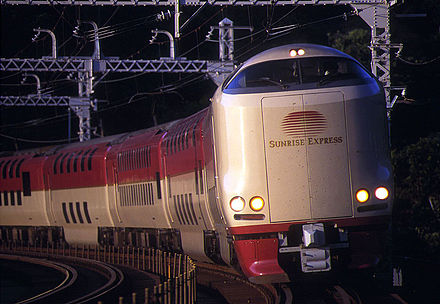
.JPG/440px-JRW_series285_'Nobinobi_Seat'_(Lower_berth).JPG)
When using these services, separate fares will have to be paid. The basic fare and limited express surcharge are both based on distance, and the accommodation charge is fixed over the entire journey. Lodging ranges from carpet spaces — where you literally sleep on the floor — to bunk bed-type compartments and private rooms. Toilets are located throughout the train, and on-board showers can be accessed for a small fee by paying for a shower card at a special vending machine - but only a limited number of shower cards are available on each trip.
The Japan Rail Pass will cover only the basic fare. If you sleep in a bunk bed or a private room, then the limited express and accommodation charges will have to be paid. On the other hand, if you sleep in the carpet space, this is considered a "reserved seat" and there is no additional charge to use it.
Overnight trains can be reserved online in English through sites such as JR West and Japan Rail Pass Train Reservation, or you can book the train after arrival in Japan. Do note that trains could sell out, especially during peak travel times, and trains are also subject to cancellation on the day of departure if inclement weather is expected.
The alternative to travelling overnight by train is to travel by bus, though if you plan to stick to train transportation there are a few other options. You could travel to your next destination during the evening hours, arrive before midnight (when most trains stop operating), and hit the ground running early the next morning. You can also split up an overnight journey by stopping at an intermediate train station along the way and resting at a nearby hotel. This works especially if you have a Japan Rail Pass, since you would generally not have to pay anything extra to use the train. If you can find accommodations in a smaller city, the chances are good that you will pay less for it compared to lodging in bigger cities such as Tokyo... not to mention you will have your own bed, bathroom and toilet. Toyoko Inn business hotels operate all over Japan — most of them near train stations — and are just one example.
If you have some extra money, consider forwarding some of your luggage to your destination using a luggage delivery service.
Deluxe excursion trains
See also: Tourist trains
 A number of excursion trains are marketed as Joyful Trains (ジョイフルトレイン joifuru torein). As of 2020, you can find as many as 50 such trains by searching for "joyful train". Some are simply ordinary rides with scenic views, while others have interesting features on board such as tatami mat seating, an art gallery (dead link: January 2023), sweet snacks made from local produce, or foot baths (dead link: January 2023). There are also character trains that generally target kids, such as the Pokémon train with a playroom car, decorated with about a million Pikachus.
A number of excursion trains are marketed as Joyful Trains (ジョイフルトレイン joifuru torein). As of 2020, you can find as many as 50 such trains by searching for "joyful train". Some are simply ordinary rides with scenic views, while others have interesting features on board such as tatami mat seating, an art gallery (dead link: January 2023), sweet snacks made from local produce, or foot baths (dead link: January 2023). There are also character trains that generally target kids, such as the Pokémon train with a playroom car, decorated with about a million Pikachus.
The various Japan Railway companies offer some sleeper trains with deluxe accommodations. The Seven Stars in Kyushu (dead link: January 2023) was unveiled in 2013 by JR Kyushu, who coined the phrase cruise train due to its long and various itineraries. The Seven Stars in Kyushu appropriately operates in Kyushu and contains 14 deluxe suites, a lounge car and a dining car.
Fares start from ¥210,000 for a one night journey and ¥480,000 for a three night journey that includes one night at a ryokan (per person, double occupancy). Despite the high cost, the excursion train has proven to be so popular that JR Kyushu holds a ticket lottery to determine who can order tickets. For example, there were over 6,800 applications for the 210 suites available for train runs between October 2015 and February 2016. Travel agencies have begun selling these itineraries at a mark-up for those who miss out on the lottery.
Due to the success of Seven Stars in Kyushu, other train companies are following suit with their own excursion trains. JR East has introduced the luxury Train Suite Shiki-shima for journeys from Tokyo to Tohoku and Hakodate in southern Hokkaido. JR West's Twilight Express Mizukaze operates itineraries between the Kansai and Chugoku regions.
The Royal Express of Izu-Kyuko Railway operates excursions from Yokohama to the Izu Peninsula.

